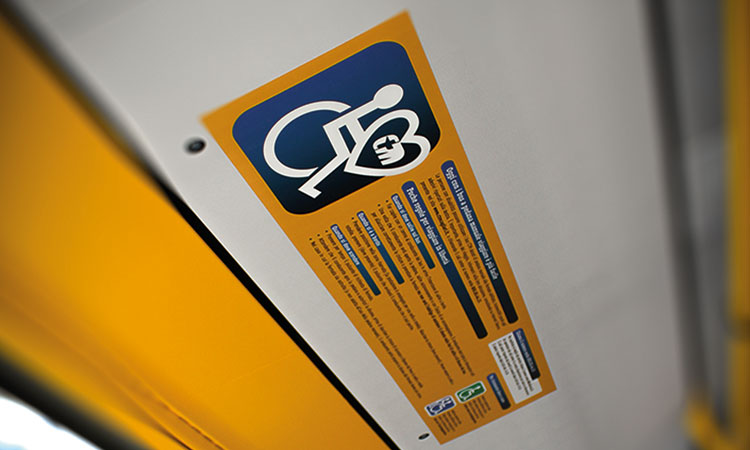Strengthening accessibility in Cagliari through buses
- Like
- Digg
- Del
- Tumblr
- VKontakte
- Buffer
- Love This
- Odnoklassniki
- Meneame
- Blogger
- Amazon
- Yahoo Mail
- Gmail
- AOL
- Newsvine
- HackerNews
- Evernote
- MySpace
- Mail.ru
- Viadeo
- Line
- Comments
- Yummly
- SMS
- Viber
- Telegram
- Subscribe
- Skype
- Facebook Messenger
- Kakao
- LiveJournal
- Yammer
- Edgar
- Fintel
- Mix
- Instapaper
- Copy Link
Posted: 4 February 2016 | Ezio Castagna (CEO), Proto Tilocca (Senior Manager), Roberto Murra (President) | No comments yet
Cagliari, a city of approximately 150,000 inhabitants, is the regional capital of the Italian island of Sardinia, as well as the main centre of a vast metropolitan area. In order to enhance the accessibility of the city’s public transport network, CTM SpA is implementing a strategy to invest in new bus fleets and improve infrastructure. CTM’s Roberto Murra (President), Ezio Castagna (CEO) and Proto Tilocca (Senior Manager), expand on the guidelines the company is following to achieve its accessibility goals.


Urban public transport in Cagliari is managed by CTM SpA, a fully owned public company that, thanks to 29 urban lines (three of which are trolleybus lines) and a fleet of 269 vehicles, provides local public transportation to serve a total customer base of almost 400,000 people, with a production of 12.5 million km per year.
With the aim to provide the highest standards of quality, CTM is certified EN ISO 9001, while 27 lines are certified according to UNI EN 13816.
Over the past 20 years, the company has implemented a strategy focused on ensuring the right to mobility for all its customers: able-bodied, disabled, elderly etc. To this end, CTM has started upgrading its bus stop network and its bus fleet, in an attempt to enhance the accessibility of public transport in the metropolitan area of Cagliari. Concurrently, a modern ITS system has been developed with the goal to improve information, regularity, and, most of all, accessibility to local public transport.
More recently, CTM’s strategy has revolved around the following four main guidelines:
- To provide the company and the metropolitan area with a modern, fully integrated, ITS system
- To renovate its bus fleet via the purchase of low-floor vehicles that are equipped with a state-of-the-art kneeling system and extendable ramps
- To offer bus stops that are accessible for disabled passengers
- To implement a door-to-door service specifically designed for people with disabilities.
Integrated ITS system
CTM has made significant interventions in the area of mobility over recent years, such as: the installation of intelligent traffic lights; monitoring and management of road traffic; real-time traffic information on traffic, circulation and parking; an AVM system of fleet monitoring and control; smart bus-stop signs; traffic light prioritisation; plus web and mobile systems for real-time access to information about the service. The project, funded with €27 million granted by the European Union has permitted to realise 10 integrated sub-stations and over 2,000 peripheral devices for the connection and coordination of public and private transport. It has also paved way for the installation of electronic bus stops in over a third of the bus stop network, and developed a technologically advanced app which recently reached 92,000 downloads.
Fleet renewal and enhanced accessibility
In recent years, CTM has renewed most of its fleet. In 2010, 171 new buses (almost 73% of the entire fleet) of different lengths (7m, 8m, 10m, 12m, and 18m) were acquired with finance leasing. In 2012, taking advantage of regional and national financing, the first set of 16 trolleybuses was replaced. Finally, the renewal of the trolleybus fleet was completed in 2015 with the purchase, by self-financing, of 16 new vehicles – six of them fully electric (ZEV) that will run in the ‘Demo’ test of the European project ZeEUS1. The last 16 vehicles will enter service in spring 2016. These purchases led to an overall reduction of the fleet average age to 5.8 years2.
For several years now, the specifications of the tenders to purchase new vehicles has placed particular attention to environmental issues (all buses equipped with Euro V EEV engines), comfort requirements (all vehicles to have air conditioning) and accessibility requirements (with particular attention to disabled people and people with limited mobility).
Today, all buses in CTM’s fleet are low-floor, with an entrance/exit maximum height of 34cm from the ground and the absence of internal steps. They are also equipped with a kneeling system (which reduces the entrance/exit height by another 7cm), in order to favour comfort and safety of passengers on their entrance and exit from the vehicle. Most of the buses (91% of the entire 2016 fleet) have a dedicated space for one wheelchair and are equipped with a manually operated platform (located on the central door) for lifting wheelchairs. The choice of the manually operated platform came not only from financial considerations but also from the simplicity of use and from its maintenance and reliability features.
In addition to the front and side information signs, all buses are equipped with exterior speakers which allow customers to identify the line and direction when the bus is reaching the bus stop. Furthermore, on-board monitors show the upcoming bus stop along the route.
Inside the bus are two (or more) speakers depending on the vehicle size, distributed throughout the length of the passenger compartment to spread the announcement of the next stop. In addition, these devices are connected to the centralised fleet management systems AVL (Automatic Vehicle Localisation) and AVM (Automated Vehicle Monitoring). In fact, all CTM’s vehicles have a system of automatic location and a system of communication between the driver and the control centre that provides real-time information about service anomalies, and to communicate with other vehicles and customers via electronic signs widespread on the CTM network.
The bus technological equipment has two different radio systems (AVM and TETRA), for redundancy purposes, available to the drivers. There also internal video surveillance equipment (CCTV and recording units) which guarantee the best safety conditions for passengers, plus there is a ‘road-scan’ system for recording images inside and outside the vehicle, which is particularly useful for the police.
If we want to see public transportation as a complex system, we must consider not only the vehicles, but also the bus stops, which are key accessibility component for customers.
Bus stops accessibility
There are 967 bus stops along CTM’s network, 301 of which are fitted with smart bus-stop signs which display real-time information of scheduled arrivals and line numbers etc. Also, 236 bus stops are equipped with shelters, including almost 80 bus shelters belonging to the city of Cagliari and managed by CTM. For the remaining bus stops, information about the scheduled times of transit, as well as general information common to all the bus stops, such as the network maps, are displayed.
CTM classifies its bus stops depending on whether or not they can be used by disabled people with limited mobility, with or without helper. Customers can identify the suitable stops by a specific logo affixed on the infrastructure of the bus stop. This information is also available through all CTM’s communication channels (website, app, phone, etc.).
With the goal to reduce architectural barriers and enhance bus stops accessibility for passengers with disabilities, CTM has started a development phase for the creation of raised bus stop platforms/access kerbs. The following three different bus stop types have been identified:
- Bus stop type A: accessible to unaccompanied wheelchair users
- Bus stop type B: accessible to accompanied wheelchair users
- Bus stop type C: not accessible to wheelchair users.
In recent years, CTM, with the involvement of various disability associations and with the partnership of municipal authorities, has paid particular attention to the problem of bus stop accessibility, identifying the adoption of a platform as an optimal solution. This system is simply an extension of the sidewalk that runs out for the entire length of the arriving bus, allowing easy access for wheelchairs, preserving at the same time the space for safe entry/exit from the vehicle. With a platform height of 21cm from ground level, the entry/exit of the wheelchair from the bus is at zero level, allowing easy access to the vehicle without any form of assistance. Furthermore, a LOGES path (Italian acronym for ‘tactile paving for the visually impaired’) is also integrated into the infrastructure.
Over recent years, approximately 30 bus stops with platforms have been built, in both the city of Cagliari and Quartu S. Elena. This approach, which appears to be the most effective solution, requires, however, availability of space, which is not always available in the urban context, and a financial commitment for the realisation of the works is needed in addition to the authorisation of the road owner.
Implementing a door-to-door service for passengers with disabilities
In addition to the ordinary service, since 2006 CTM has also operated, in the same urban area, a complementary door-to-door service called Amicobus, dedicated to disabled people who are not able to reach bus stops within the urban network. This service, available by appointment and carried out with a helper on-board, is available from 7:00 to 20:00 on working days, and from 7:00 to 14:00 on Saturdays. To access the service, customers must simply phone the call centre or book an appointment on the CTM website3. The call centre is responsible for coordinating and monitoring the booking process, plus guaranteeing the safety and reliability of the service itself.
The purchase of new buses for the Amicobus service is expected to take place over the coming months; the vehicles will have a section for two wheelchairs and are equipped with an electro-hydraulic system for lifting the wheelchairs.
Figure 3 (below) shows the distribution of the demand within the metropolitan area of Cagliari. The distribution of the red dots is a clear indicator of the complexity of Amicobus, with several sophisticated optimisation algorithms built over the years in order to improve the service functioning.


Figure 3
Demand intercepted
To maintain the highest standard of quality service in the future, CTM is willing to maintain, even by making use of its own resources, the average age of its fleet to be below seven years. Additionally in the future, the company is particularly interested in purchasing additional ZEV vehicles.
Conclusions
In the near future, CTM will continue to purchase buses and trolleybuses that will enable optimal accessibility for all categories of users, in particular by promoting the safety and comfort of travellers (increasing therefore the amount of seats) and in the delivery of further on-board equipment that will make use of state-of-the-art technologies.
Other courses of action will be the enhancement of the services dedicated for the disabled and increasing in the number of bus stops equipped with platforms (where possible) since they have proved to be a very effective solution.
Finally, CTM will work on the strengthening of communication tools (web and app) which, under request, allow identifying easy access and routes with interchanges between the lines with bus stops equipped for disabled customers.
References
- zeeus.eu
- At 1 February 2016
- ctmcagliari.it
Biography






Related topics
Fleet Management & Maintenance, Infrastructure & Urban Planning, Intelligent Transport Systems (ITS), Multimodality, Passenger Accessibility, Sustainable Urban Transport, Transport Governance & Policy
Issue
Issue 1 2016
Related modes
Bus & Coach
Related cities
Cagliari
Related organisations
CTM SpA








